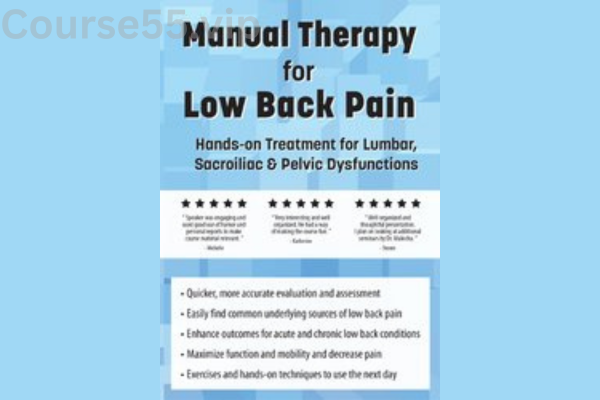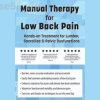Manual Therapy for Low Back Pain: Hands-on Treatment for Lumbar, Sacroiliac, & Pelvic Dysfunctions By Ted German – PESI
$249.00 Original price was: $249.00.$23.10Current price is: $23.10.
Review manual therapy for low back pain: Hands-on treatment for lumbar, sacroiliac, and pelvic dysfunctions by Ted German – Digital Download!

Manual Therapy for Low Back Pain: Hands-on Treatment for Lumbar, Sacroiliac, & Pelvic Dysfunctions By Ted German – PESI
Overview

Review of Manual Therapy for Low Back Pain: Hands-On Treatment for Lumbar, Sacroiliac, and Pelvic Dysfunctions by Ted German
Low back pain (LBP) is a widespread condition that affects millions globally, leading to reduced quality of life and increased healthcare expenses. Addressing this issue requires a multifaceted approach, and one method that has gained traction is manual therapy. In the course Manual Therapy for Low Back Pain: Hands-On Treatment for Lumbar, Sacroiliac, and Pelvic Dysfunctions, Ted German provides an in-depth framework for understanding how manual therapy can be used to treat LBP. This review examines the course’s methodologies, effectiveness, and overall significance, offering insights into the potential benefits of manual therapy for those dealing with lumbar, sacroiliac, and pelvic dysfunctions.
Understanding Manual Therapy and Its Importance
Manual therapy involves various hands-on techniques aimed at reducing pain and restoring musculoskeletal function. The course focuses on the lumbosacral region, an area known for its complexity and diagnostic challenges. Ted German highlights the critical connection between structural alignment and functional movement, which directly influences treatment effectiveness.
Many healthcare practitioners favor manual therapy because of its direct, hands-on nature. The techniques covered in the course include spinal manipulations that range from gentle mobilization to more forceful adjustments, depending on the patient’s condition. The success of these treatments largely depends on the therapist’s ability to assess each patient’s unique dysfunctions and apply appropriate interventions.
Despite the growing use of manual therapy, its overall effectiveness remains a topic of debate. Some studies suggest that while manual therapy can provide pain relief, its superiority over other treatments—such as physical therapy or medication—remains inconclusive.
Evaluating the Effectiveness of Manual Therapy
Research presents a mixed perspective on the efficacy of manual therapy for LBP. While numerous studies indicate that manual therapy can alleviate pain, it does not consistently outperform alternative treatments or even placebo interventions. A comprehensive review of existing research found no definitive evidence supporting manual therapy as the most effective standalone treatment for low back pain.
However, when integrated into a broader treatment plan, manual therapy has demonstrated positive results. Studies suggest that combining manual therapy with exercise and patient education significantly improves outcomes. This approach acknowledges the complex nature of LBP, recognizing the need to address both physical and psychological factors. Practitioners are encouraged to adopt a holistic view, considering individual differences in diagnosis, treatment response, and patient preferences to achieve the best results.
Practical Implementation of Manual Therapy
One of the strongest aspects of Ted German’s course is its emphasis on practical, hands-on training. The course equips participants with essential skills for manual assessment and treatment, ensuring that techniques are adapted to meet each patient’s specific needs. This personalized approach plays a key role in achieving optimal recovery outcomes.
Core Techniques and Treatments
The course introduces several key manual therapy techniques, including:
- Spinal Manipulative Therapy (SMT): Particularly beneficial for acute LBP, helping to restore mobility and reduce pain.
- Joint Mobilization: Aims to improve joint lubrication and movement, enhancing flexibility and function.
- Soft Tissue Techniques: Focuses on releasing muscle tension and manipulating soft tissues to relieve discomfort.
These techniques are most effective when combined with patient education and self-care strategies. The course emphasizes the importance of empowering patients with knowledge about their condition, equipping them with tools such as exercise routines and lifestyle adjustments to support long-term recovery.
Course Accessibility and Cost
Ted German’s manual therapy course is available for $59.99, a reduced price intended to make it accessible to healthcare professionals interested in expanding their expertise in treating low back pain. This affordability enhances its value, allowing a wide range of practitioners to gain insights into effective manual therapy techniques.
Limitations and Considerations
While manual therapy offers valuable treatment options, it is essential to recognize its limitations. It should not be seen as a standalone solution but rather as a complementary component of a well-rounded treatment strategy. Additionally, some patients may respond better to alternative treatments or may have conditions that contraindicate manual manipulation. A thorough assessment is necessary to determine the most appropriate approach for each individual.
Conclusion
Ted German’s course, Manual Therapy for Low Back Pain, presents a structured and practical guide for addressing lumbar, sacroiliac, and pelvic dysfunctions through hands-on techniques. While debates continue regarding its effectiveness compared to other treatments, its role as part of a comprehensive care plan is increasingly recognized.
Practitioners are encouraged to take a patient-centered approach that integrates education, exercise, and tailored manual therapy techniques to enhance treatment outcomes. By adopting a holistic perspective, healthcare providers can better support individuals suffering from low back pain. As pain management strategies continue to evolve, incorporating manual therapy within a broader care framework may lead to more effective, long-term relief for patients.
Frequently Asked Questions:
Business Model Innovation: We operate a group buying strategy, allowing participants to share costs and access popular courses at reduced prices. This model benefits individuals with limited financial resources, despite concerns from content creators about distribution methods.
Legal Considerations: The legality of our operations involves complex issues. Although we don’t have explicit permission from course creators to resell their content, there are no specific resale restrictions stated at the time of purchase. This ambiguity creates an opportunity for us to provide affordable educational resources.
Quality Control: We ensure that all course materials purchased are identical to those offered directly by the creators. However, it’s important to understand that we are not official providers. As such, our offerings do not include:
– Live coaching calls or sessions with the course author.
– Access to exclusive author-controlled groups or portals.
– Membership in private forums.
– Direct email support from the author or their team.
We aim to reduce the cost barrier in education by offering these courses independently, without the premium services available through official channels. We appreciate your understanding of our unique approach.
Be the first to review “Manual Therapy for Low Back Pain: Hands-on Treatment for Lumbar, Sacroiliac, & Pelvic Dysfunctions By Ted German – PESI” Cancel reply
You must be logged in to post a review.

 PTSD in Veterans: Impact of PTSD on Military Personnel and War Veterans and Their Families By Michael Gatson - PESI
PTSD in Veterans: Impact of PTSD on Military Personnel and War Veterans and Their Families By Michael Gatson - PESI 














Reviews
There are no reviews yet.